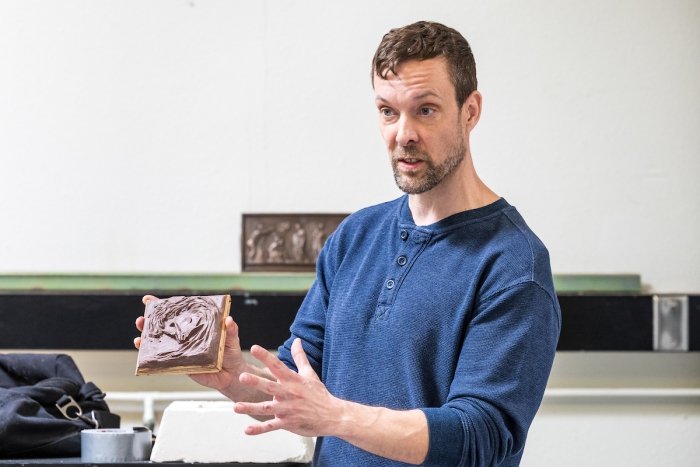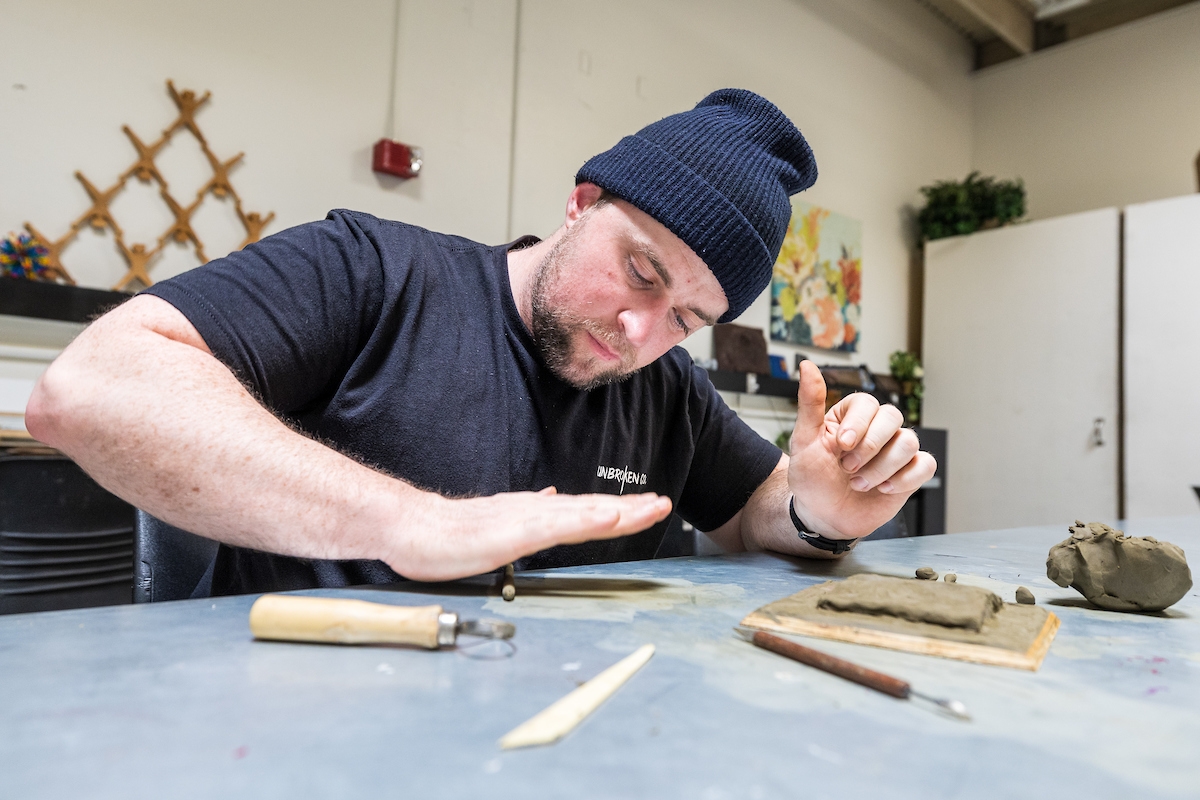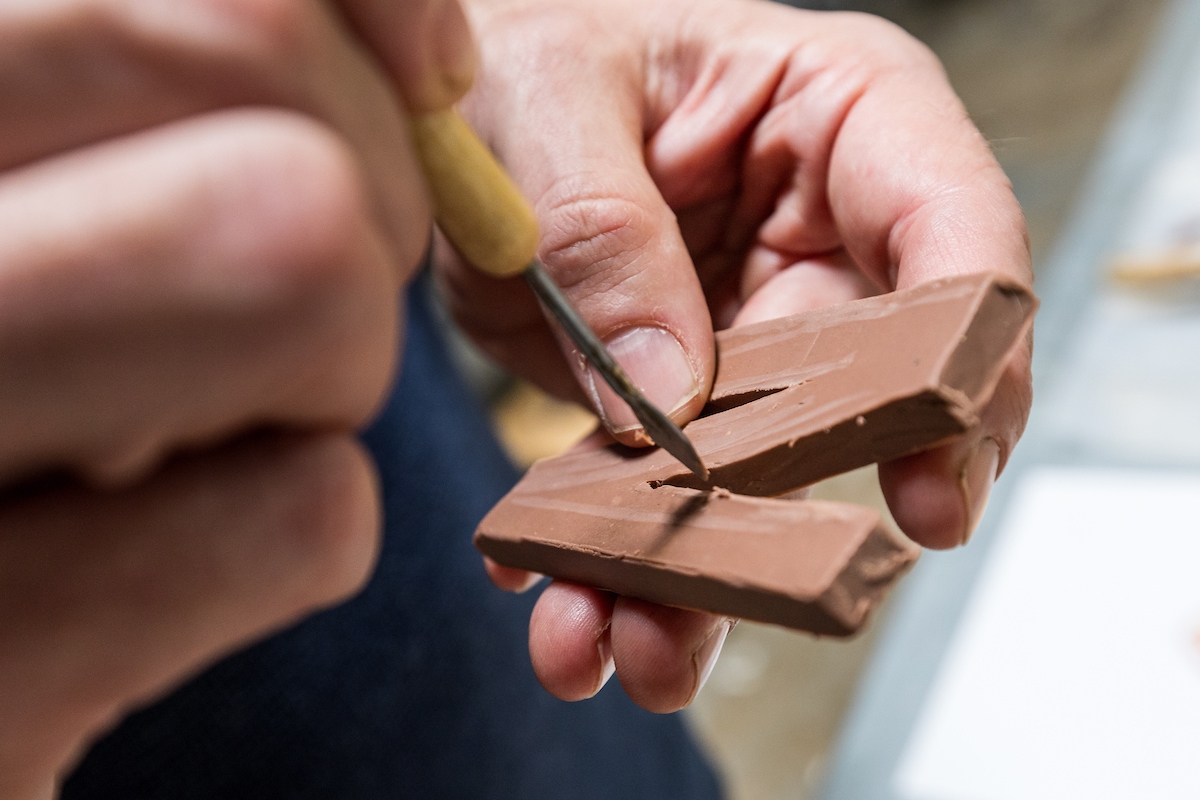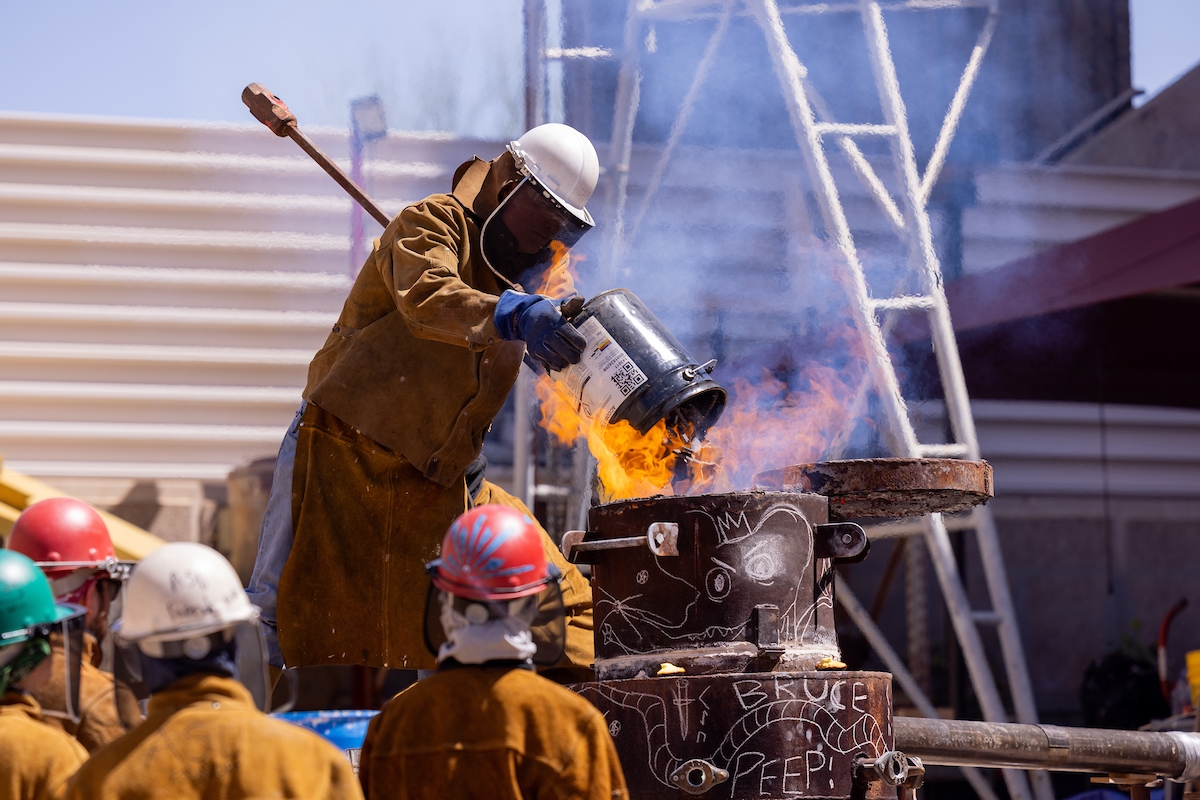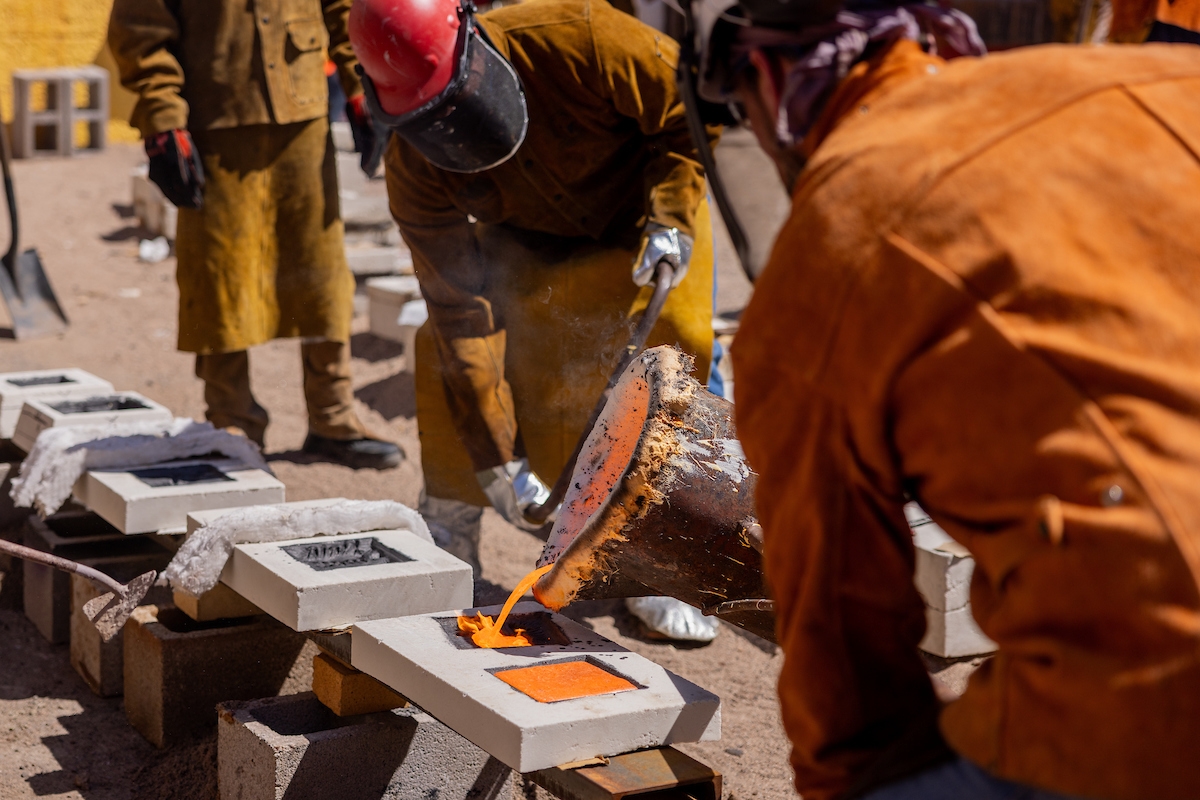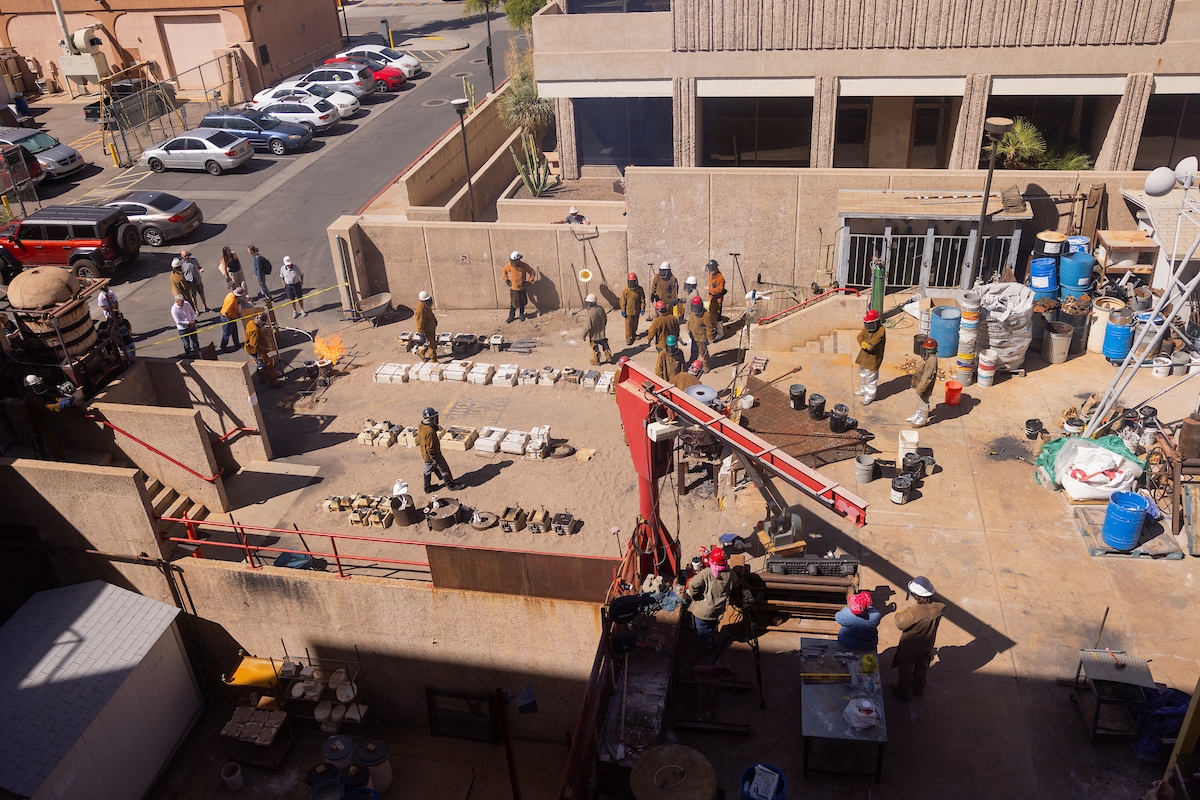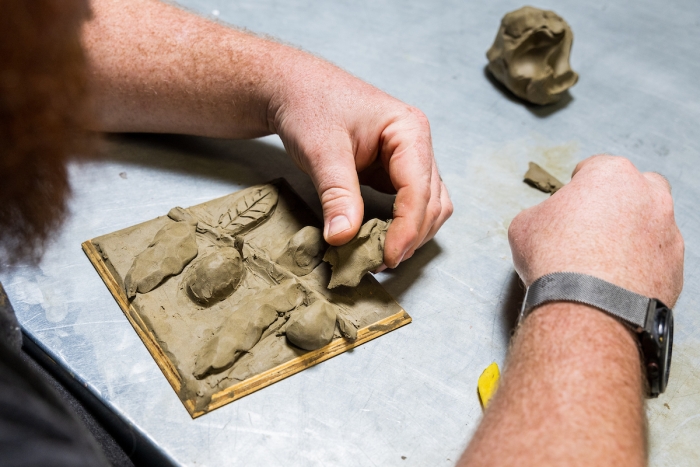'Devils in the Metal': ASU vet leads iron cast workshop for former service members

Social work graduate student and Army veteran Sonia Carrasco adds a patina solution to a heated large logo on Saturday, April 20, at ASU's School of Art warehouse. A handful of student veterans affiliated with the university are working on sculptures as part of a program called "Devils in the Metal." The program is run by Bruce Ward, a veteran and ASU BFA alumnus working with the Pat Tillman Veterans Center, and assisted by ASU art faculty. Photo by Charlie Leight/ASU News
Bruce Ward believes everyone has a symbol of strength or resilience, and they have an obligation to find it.
His happens to be a paper crane in an ocean wave.
“It’s the idea that we are the ocean and we are all connected, and that our ego is a paper crane,” said Ward, an Arizona State University student veteran who served in the marines from 2001–06. “You’ve focused so much energy on who you are as an individual, but you’d better enjoy it all while it lasts because you’re about to become a piece of the ocean again one day. It’s carpe diem — enjoy surfing the wave while you have it.”
Ward discovered his symbol a few years ago after being diagnosed with Post Traumatic Stress Disorder after serving two tours of duty in Iraq. He found transition back to civilian life tough and harder than expected.
“I had some serious problems leaving the Marine Corps and unfortunately I had no coping skills,” Ward said. “I was using drinking as a coping mechanism, which turns out not to work. After a few years of incarceration, I started thinking, ‘Maybe I’d better try and become the best version of myself that I can possibly be.’”
With a Bachelor of Fine Arts in sculpture from ASU’s Herberger Institute for Design and the Arts, Ward is well on his way. He is teaching other veterans what he has discovered on his journey to healing and self-discovery. Ward recently wrapped "Devils in the Metal: Veterans Iron Casting Workshop” — a three-week pilot program designed to engage a handful of other veterans in a dialogue about their inner sources of strength and motivation.
The workshop was sponsored by ASU’s Pat Tillman Veterans Center and Swire Coca Cola, Arizona, which paid $5,000 for art supplies, instruction and all other associated costs.
“Through the medium of art and the work Bruce is doing, this workshop provides the vision some of our student veterans need to flourish here at ASU,” said Shawn Banzhaf, executive director of the Pat Tillman Veterans Center. “We consistently see a need for whole life wellness programming and our team at the PTVC continues to provide value-added experiences like ‘Devils in the Metal.’ Our center supports and is inspired to see student veterans like Bruce Ward giving back to his fellow veterans, and we are extremely proud of his success.”
The workshop commenced on March 16 in the foundry at ASU’s School of Art. Ward, with the assistance of sculptors John Tuomisto-Bell and Chris Luper, guided five veterans on the basic steps of metal-pour foundry techniques involving clay patterning, resin-bonded sand molding, iron-pour fundamentals and patina application.
Participants worked on their own individual sculptures as well as a group sculpture, which was a cast iron mold of the Pat Tillman Honor Shield. This will be presented to the Tillman Center on Aug. 16, along with a planned ceremonial unveiling.
Ward also guided the participants in conversation focused on personal iconography of strength and motivation with the goal of selecting a symbol based on their achievements and motivations.
He started by asking them to think about the most stressful moment during their military career and to reflect on a personal symbol of resistance that got them through their ordeal.
Sonia Carrasco, an Army veteran who served in Afghanistan, said she uses art therapy to help her combat stress. She has also participated in Guitars for Vets and Huts for Vets, both wellness programs geared towards helping ASU student veterans.
“Bruce's art therapy workshop allows you to explore your creativity and unlock the transformative power within,” said Carrasco, who is a social work graduate student and a senior success advocate at the Tillman Center. “Through creative expression, you embrace the journey of self-discovery and watch as your inner world blossoms with newfound clarity and resilience.”
Carrasco selected a heart as her personal symbol of resilience.
“When I go hiking, I feel like my heart starts to pound extra hard. It’s telling me that I’m alive,” Carrasco said. “It’s a great feeling when I’m done.”
Air Force veteran Marc Biren is the very embodiment of resilience. A week before the first class, he suffered a heart attack while hiking South Mountain in Phoenix.
“I could have easily come up with excuses not to come today, but Bruce is my friend, and I’m glad I didn’t allow my mind to get away with that,” said Biren, a research professional in ASU’s School of Earth and Space Exploration. “I’ve been married since 1988, and we’re homebodies. I value what I learned in my 20 years in the military, and so it’s great to be around other people who are going through similar growth. On a personal level, I’ve really enjoyed seeing Bruce in his element.”
Biren’s personal symbol of resilience is a smooth mirror.
“This is related to Tibetan Buddhism, and the idea is to get to the point where our mind is similar to a smooth mirror in that we’re not altering what we’re experiencing, because that’s not growth,” Biren said. “I’ve had 10 years of sobriety and where I’m at now is I’m doing an undergrad part time in counseling and applied psychology. I want to help people with their addiction issues and help them to use their mind as a benefit instead of treating ourselves poorly.”
Navy and Marine veteran Ian Burton admits he’s not very creative but signed up for the workshop because he wanted to do something out of his comfort zone.
“I like the idea of using the problem-solving part of my brain as well as using my creative side to make something tangible,” said Burton, who is a current student veteran majoring in industrial design from the Herberger Institute for Design and the Arts with a minor in project management at The College of Liberal Arts and Sciences. “It calms me down and makes me feel as I’m doing something worthwhile. I like taking things that exist in my head and transforming it to something that’s real.”
A three-dimensional book is Burton’s symbol of resilience.
“Knowledge is power, and reading and learning is very enjoyable and relaxing to me,” said Burton, who served in Iraq. “The older I get, the more I want to learn about everything.”
Vance Leland, who served in the Army from 2007 to 2013, works in global investigations and wanted to find a creative outlet for himself.
“I’ve always been interested in metal work but have never done anything,” said Leland, who graduated from ASU’s School of Public Affairs. “This sounded really interesting and a good way to work with my hands.”
Leland’s symbol of resistance is an olive branch.
“It’s a universal symbol of peace, but I also have a 2-year-old daughter named Olive,” Leland said. “When it’s just me and her and we’re all alone, nothing else matters.”
Tuomisto-Bell, a marine veteran and professional artist, witnessed that sense of calm sweep over the five veterans over the course of three weeks.
“When you can tap into your creativity, it enables you to deal with a lot of internal emotions and the things you had to do in the military,” said Tuomisto-Bell, who holds a Master of Fine Arts in sculpting from ASU’s School of Art. “Bruce, having seen that kind of experience, helps them not only assimilate into civilian life better, but also helps them come to terms with their creative side.”
Other life lessons came to the fore. For Carrasco, it was this:
“Embrace the challenge, nurture your growth and remember progress isn’t about comparing lanes, but about finding your own pace and staying true to your journey.”
Get involved
The Pat Tillman Center continues to welcome sponsorship to help support the program for years to come. Those interested should contact Michelle Loposky, director of Development and Strategic Partnerships at the Tillman Center.
More Arts, humanities and education

ASU’s Humanities Institute announces 2024 book award winner
Arizona State University’s Humanities Institute (HI) has announced “The Long Land War: The Global Struggle for Occupancy Rights” (Yale University Press, 2022) by Jo Guldi as the 2024…

Retired admiral who spent decades in public service pursuing a degree in social work at ASU
Editor’s note: This story is part of coverage of ASU’s annual Salute to Service.Cari Thomas wore the uniform of the U.S. Coast Guard for 36 years, protecting and saving lives, serving on ships and…

Finding strength in tradition
Growing up in urban environments presents unique struggles for American Indian families. In these crowded and hectic spaces, cultural traditions can feel distant, and long-held community ties may be…
